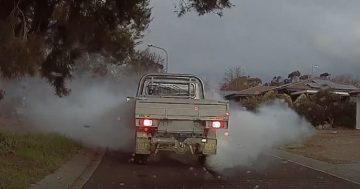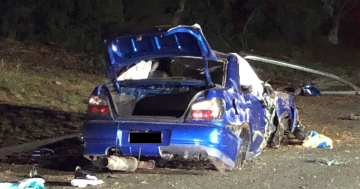
ACT Policing has made its submission to the Inquiry into Dangerous Driving. Photo: Claire Fenwicke.
Tracking darts, drones and electronically immobilising your car – these were just some of the technological options being explored by ACT Policing as part of an effort to reduce and stop dangerous driving across Canberra.
But policing was just one piece of the puzzle, with court attitudes to granting bail and the introduction of new laws also part of ACT Policing’s September* submission to the Inquiry into Dangerous Driving, which has now been made public.
ACT Policing said it was experiencing an “escalation” in drivers failing to stop for police and related criminal behaviour involving motor vehicles.
“ACT Policing has a genuine concern that it is only a matter of time before a police fatality is realised,” it submitted.
There have been almost 4,500 incidents of a driver failing to stop for police when signalled in the past five years.
ACT Policing warned the link between failing to stop for police and other serious offences could not be “overemphasised”, pointing to the deaths of Clea Rose in 2005, three-month-old Brody Oppelaar and his parents Scott Oppelarr and Samantha Ford in 2010, and Linda Cox in 2012.
To combat recidivist offending and dangerous driving practices on our roads, ACT Policing has already implemented Operation Toric and is also conducting research into how to stop these people from putting themselves and others at risk.
ACT Policing was also exploring a number of technological capabilities.
One was Automatic Numberplate Recognition (ANPR), which police already used in a limited capacity. ACT Policing wanted to expand the system into their vehicles, static systems and utilise live feeds from established cameras (such as the tram line and fixed traffic cameras) to provide live data of a vehicle of interest.
StarChase, which deployed a GPS-tracking device onto an offending vehicle via an adhesive, foam projectile, was another technology police were interested in.
“[It can] aid the rapid recovery of an offending vehicle without the requirement to pursue or re-engage a vehicle, creating a much safer option for both police and the community,” ACT Policing said.
Research was underway into how local police could use drones to track fleeing vehicles, with a working group already established to examine the legal and practical matters of this option.
ACT Policing said one challenge was adhering to the Civil Aviation Safety Authority’s (CASA) regulations and requirements in Canberra, with rules around proximity to airports and protected areas such as Parliament House.
“The greatest hurdle is to meet CASA’s requirement to pilot a drone beyond ‘the line of sight’ in a dynamic and unplanned route,” it said.
Alternatives to stop sticks and enhanced roadside drug testing were also being explored.
Looking to the future, vehicle ‘telematics’ was an area ACT Policing was interested in.
Manufacturers were increasingly embedding GPS or onboard diagnostics to track vehicles and monitor systems.
ACT Policing said this could remotely immobilise a vehicle with an owner’s consent, removing the need for a pursuit.
“[We] will soon commence a working group with partner agencies to assess the wider use of this technology,” it said.
In the meantime, ACT Policing encouraged those with newer vehicles to check if they had tracking capabilities and learn how to use this feature should their vehicle be stolen.
“While the immobilisation technology is not yet at a point for effective use, GPS tracking is available in many newer vehicles, including BMW, Mercedes, Toyota and Mazda,” it said.
“Manufacture-installed GPS has already aided in the swift recovery of stolen vehicles and apprehension of offenders in the ACT.”
But the force pointed out that policing was just one part of the solution.
It wanted more prevention strategies, including targeting, enforcement, road design strategies and education.
It also submitted the courts had a larger role to play.
ACT Policing said while it believed the current legislated penalties for the “majority of offences” were sufficient, the courts weren’t implementing them to their full potential.
“ACT Policing believes one result of the current approach to sentencing and granting of bail or lack of bail conditions imposed by the ACT Courts is recidivism, as the punishments handed down by the courts are not a deterrent for these offenders,” it submitted.
“For the offences where presumption against bail does not exist, ACT Policing observes that it is assumed there is a presumption for bail for all other offences, rather than the courts adopting a neutral position and determining the granting of bail on the particular circumstances of each case.”
Currently, a person charged with an offence punishable with less than six months in prison had the presumption of bail and was entitled to be granted bail.
There’s no presumption for bail for offences such as manslaughter, serious sexual offences or a recidivist of violent crimes.
There’s a presumption against bail for murder and certain serious drug offences.

ACT Policing submitted recidivism was one result of the court’s “current approach to sentencing or granting of bail”. Photo: Michelle Kroll.
ACT Policing said it intended to seek an agreement from the Legislative Assembly to schedule a number of offences to ensure there was a neutral position for the granting of bail.
These offences included assaulting a police officer, driving at police, and recidivist serious motor vehicle offenders.
“ACT Policing believe these proposed changes to the legislation, particularly for … recidivist offenders, would provide greater safety for police, especially for dangerous driving offenders who drive at police, both in vehicles and on foot, to avoid apprehension,” it said.
“[Officers] regularly encounter recidivist offenders for driving matters being released on bail only to commit further offences shortly after.”
It gave an example case study where a young person breached their bail conditions 10 times but was repeatedly granted bail with the same conditions.
“During this time the young person continued to offend and was involved in incidents of burglary, property damage, riding/driving in a stolen motor vehicle, possessing weapons (knife, axe), fraud, unlawful possession of stolen property; and allegations of assault, driving a stolen motor vehicle, and dangerous driving causing a vehicle collision,” ACT Policing submitted.
“[This] demonstrates that in many circumstances bail conditions are not sufficient and do not necessarily stop or deter offending.
“Alternatives need to be put in place to deter offenders from committing further offences when released on bail.”
ACT Policing said there were a number of options it believed would be effective in managing repeat offenders, including:
- A High Risk-Offenders scheme for repeat drink and drug drivers, along with tailored welfare support
- Electronic monitoring to supervise serious offenders and defendants in the community
- Changing the name of the offence ‘culpable driving causing death’ to ‘vehicular homicide’ and increasing the maximum penalty from 14 years to 20 years to be brought in line with manslaughter
- Creating an Immediate Suspension Notice (ISN) for speed over 45 km/h, as well as for burnouts, hooning, drifting and street racing
- Creating an equivalent of Skye’s Law (NSW) which makes evading a police pursuit a specific offence
- Extend the time police could seize a vehicle from 10 days to 90 days
- Increase penalties for using a mobile phone while driving to a $1000 fine and four demerit points, in line with Queensland legislation
- Increase the penalty for assaulting a police officer.
ACT Policing said it looked forward to working with the government and stakeholders to improve responses to dangerous driving behaviour and reduce road trauma in the Capital.
The first public hearings will be held on Wednesday, 26 October, and Thursday, 27 October.
*Data was current to September 2022.





















